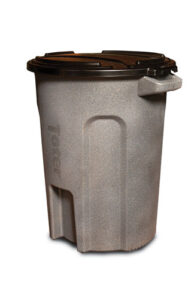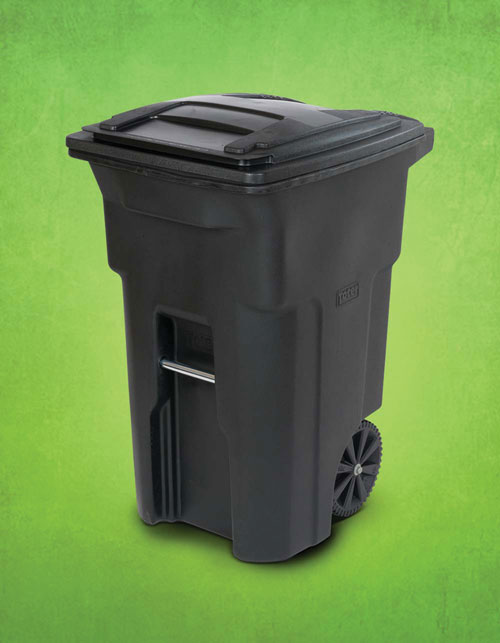For those looking to pick the right containers for waste disposal and/or recycling at their home or business, the decision should not be made lightly. The containers’ functionality, aesthetics, durability/longevity and sustainability are all important factors to consider.
A convenience that most of us seem to take for granted in the 21st century, the trash can, has not been around forever. In fact, in the grand scheme of societal evolution, the garbage bin is a relatively modern development. It dates back to the mid 1870s, when metal and wooden garbage receptacles were first introduced in England and were used to store ashes from burnt waste. (Americans started using trash cans about a decade later, soon after the first garbage incinerators began being built in the U.S.).

A Hygienic Helper
Before trash cans and incinerators came along, disposing of waste was a dirty—and sometimes even dangerous—affair, especially in urban areas. For many centuries, humans would simply throw their household trash into the city streets, bury it in holes, dump it in bodies of water or burn it onsite. And when garbage piled up, it frequently led to problems including terrible odors, the proliferation of rats and other pests, the contamination of water supplies, and even the spread of diseases like the black plague and yellow fever.
Clearly, to support public health and proper sanitation, better solutions needed to be developed. The introduction of the trash can helped facilitate big improvements in the removal and disposal of household waste, eventually helping to usher in the modern age of waste disposal. Among the advantages that the trash bin delivers for modern households and businesses are:
• Cleanliness and odor control—Obviously, having a designated receptacle for placing items that need to be disposed of or recycled helps keep homes and businesses cleaner and less cluttered. Covered garbage bins can also help keep undesirable odors contained, while specialized liners in today’s garbage cans can help control waste leakage.
• Safety—When spaces in a home or business are free of the clutter and mess created by improperly disposed waste, this can greatly reduce the likelihood of any accidents caused by tripping, slipping or falling. It can also help reduce the risk of fires posed by scattered waste materials such as flammable paper products.
• Health—Further, when waste is properly contained and covered in garbage containers, it helps limit the potential for invasion by rodents and insects—both of which can foster the spread of illnesses and disease when an infestation occurs.
• Improved business operations—By helping businesses control all of the factors mentioned above, garbage bins can lead to improved business operations and an added sense of professionalism in the workplace.
Four Top Trash Can Considerations
As simple as the trash can may seem, its benefits and characteristics can vary widely between types and brands. Consider these four reasons it is important to choose the right containers to meet your household’s or business’s waste disposal and/or recycling needs.
#1: Functionality
Today’s garbage and recycling bins are created to facilitate a wide range of everyday purposes—from simple waste disposal to organics collection, medical waste containment, the collection and sorting of recyclable materials, and more. They are also made in a range of sizes to accommodate varying volumes of waste and recycling production by users, and they are built to serve in diverse usage scenarios, such as indoor versus outdoor environments.
In addition, helpful bin characteristics can include portability and handling features like wheels and specialized handles—such as the unique third handle that select trash cans incorporate to allow for easier lifting and emptying.1 Further, some bins feature specialized characteristics like fire resistance and protection against potential invaders like raccoons and bears. The latter of these benefits, for example, can be seen in Bear Tough Carts2, which are designed to minimize conflicts with bears and other wild animals by incorporating a locking mechanism to keep wildlife out and trash in, along with being built strong enough to withstand repeated clawing and chewing. When specific requirements need to be met, be sure to choose the waste container that best fits the user’s intended purpose.
#2: Aesthetics
Modern waste and recycling containers are no longer limited to traditional color options, like green and brown—a full spectrum of bin colors are available to better match home and business décor, as well as for branding and identification purposes among municipalities and waste-handling businesses. Further, modern waste bins can be found in an array of styles for a better fit with—for example, interior design themes. Once you have determined the best container type for your needs, be sure to explore all of the aesthetic options available before making your final bin choice.

#3: Durability and Longevity
The life expectancy of a trash or recycling container is always an important purchase consideration—and it can vary greatly depending on the composition and build of the product chosen. A more durable container lasts longer, of course, leading to cost savings that are achieved via fewer needed repairs and longer intervals between required replacements.
Among the ways that composition can support container durability, using linear medium-density polyethylene (MDPE)3 that is specifically engineered for toughness and high-impact resistance leads to a more durable container. Alternatively, using high-density polyethylene (HDPE) results in a rigid and brittle container that offers poor impact resistance. Further, providing an example of how a cart’s build can contribute to container durability, carts made using the Advanced Rotational Molding™ process—as opposed to being injection-molded—exhibit maximum impact strength and improved physical properties.
Exhibiting the life span-lengthening differences that improved composition and build can make, a 2020 lifecycle analysis (LCA)4 showed that customers with certain premium carts reported an average service life of 11 years for their containers, as opposed to just nine years for other cart types. Further, according to surveyed waste haulers and municipalities, three times as many customers with such premium carts reported a 15- to 20-year life span for their containers, as opposed to an average life span of 5 to 10 years for other cart types.
#4: Sustainability
Of course, the increased bin service life noted above provides big environmental benefits, as added container longevity can prevent the need to make more bins—thus eliminating the need to use more natural resources in the process. Waste and recycling containers can also be produced using methods and materials that place a greater focus on eco-friendliness and resource preservation, such as making carts that incorporate recycled materials.5
More sustainable cart options have been on the market since at least the early 1990s, and since then, they have evolved to include recent innovations such as the industry’s very first cart body manufactured from 100 percent recycled content.6 And considering that more than 90 percent of the plastic produced globally is never recycled7, from a sustainability standpoint, these types of carts mark a clear step in the right direction for the industry.
In conclusion, for those looking to pick the right containers for waste disposal and/or recycling at their home or business, the decision should not be made lightly. The containers’ functionality, aesthetics, durability/longevity and sustainability are all important factors to consider. | WA
Toter® is a leading provider of waste and recycling carts to waste haulers and municipalities in North America. Additional products include specialty carts for document management, electronic waste, organics, medical waste and more. Manufactured using Advanced Rotational Molding, Toter carts offer a greater service life than injection-molded carts. Toter is also the only commercial-grade cart available to consumers at retailers nationwide. Toter is a division of Wastequip. To learn more about Toter and its broad range of offerings for waste collection and disposal, visit www.toter.com. To learn more about Toter’s commitment to environmental sustainability, visit www.toter.com/about-us/project-25.
Wastequip is a leading North American manufacturer of waste handling equipment, with an international network of manufacturing facilities and the most extensive dealer network in the industry. Wastequip’s broad range of waste and recycling equipment, trucks, and systems is used to collect, process, and transport recyclables, solid waste, liquid waste and organics. The company’s brands include Wastequip®, Toter®, Galbreath, Pioneer™, Mountain Tarp®, Amrep®, Confab®, Wastequip WRX™, Wastebuilt®, Container Pros®, wasteware™ and Accurate™. For more information, visit www.wastequip.com.
Notes
www.toter.com/products/industrial-commercial-institutional/round-trash-cans
www.toter.com/products/homeowners/bear-tough-carts-bear-resistant-trash-cans
www.toter.com/about-us/sustainability
www.toter.com/about-us/project-25: One prominent example of this can be seen in Toter’s EVR-Green, the waste and recycling industry’s first cart body produced from 100 percent recycled material. The eco-conscious cart is produced as part of Toter’s Project 25 initiative, which exhibits the company’s dedication to sustainability with a commitment to reducing the amount of virgin resin used in its cart manufacturing by 25 percent. The move would reduce Toter’s carbon footprint by at least 9 percent per cart.
www.nationalgeographic.com/science/article/plastic-produced-recycling-waste-ocean-trash-debris-environment
